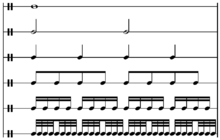Half note


| Drum pattern, accompanied by ride patterns of various duple lengths from | |||
In music, a half note (American) or minim (British) is a note played for half the duration of a whole note (or semibreve) and twice the duration of a quarter note (or crotchet). It was given its Latin name (minima, meaning "least or smallest") because it was the shortest of the five note values used in early medieval music notation (Morehen and Rastall 2001). In time signatures with 4 as the bottom number, such as 4
4 or 3
4, the half note is two beats long. However, when 2 is the bottom number (including alla breve, 2
2), the half note is one beat long.
Half notes are notated with a hollow oval notehead like a whole note and straight note stem with no flags like a quarter note (see Figure 1). The half rest (or minim rest) denotes a silence of the same duration. Half rests are drawn as filled-in rectangles sitting on top of the middle line of the musical staff, although in polyphonic music the rest may need to be moved to a different line or even a ledger line. As with all notes with stems, half notes are drawn with stems to the right of the notehead facing up when they are below the middle line of the staff (on or below the middle line in vocal notation). When they are on or above the middle line (just when they are above this line in vocal notation), they are drawn with stems on the left of the notehead facing down.
The American term half note is a 19th-century loan translation of German halbe Note.
The Catalan, French, and Spanish names (meaning "white") derive from the fact that the minima was the shortest unfilled note in mensural white notation, which is true of the modern form as well. The form in the earlier black notation resembles the modern quarter note (crotchet). The Greek, Chinese, Japanese, and Korean names mean "half", and in Greek, the modern word (miso – μισό) and older (imisi – ήμισι) are used.
| Look up half note or minim in Wiktionary, the free dictionary. |
See also
References
- Morehen, John, and Richard Rastall. 2001. "Minim". The New Grove Dictionary of Music and Musicians, second edition, edited by Stanley Sadie and John Tyrrell. London: Macmillan Publishers.